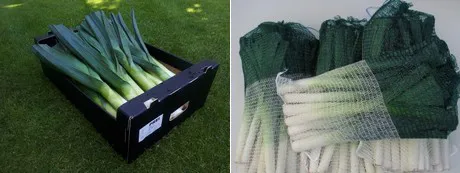Leek demand has been normal this summer, says Paul van den Elzen. He is from Van den Elzen Groentenverwerking in the Netherlands. But, Paul is optimistic about the remainder of the season. "I think the drought in all the growing countries will create demand. There are fewer kilos everywhere, which will cause issues, and thus shortages, two months from now."

"Prices are currently very normal, between €0.55 and €0.60 on the free market. That's climbing slightly, but isn't where it should be, while costs have risen ten to 15%. The first Dutch schools have only just reopened, and it's still very hot this week. All that has an impact, too," says Paul.
"Our customers are all over Europe, from supermarkets to restaurants and from market traders to vegetable processors. At the moment, the former Eastern Bloc countries are doing particularly well on the market. Sales towards southern European countries like Spain, Italy, and Portugal, but also Scandinavia are much calmer."
Drought, thrips, and water
Dutch leek cultivation has not escaped the drought. "Less supply is coming off the land. There are leeks in stock, but they have plenty of issues. Thrips are an especially significant problem - They infest leeks that don't want to grow. And we no longer have the means at our disposal to combat this," Paul explains.
"Water, too, is a problem. We're irrigating a lot, but natural rainwater is always better, especially since some wells contain rust. That's more damaging to the leaves. We use a watering boom between the rows to irrigate the larger leeks. So, the water doesn't hit the crop and can run 24/7."
The grower says there has been limited product development in leeks in recent years. "People prefer 3cm leeks and slightly shorter shafts of about 40cm, so that's what we grow. We try to innovate and automate as much as possible," Paul continues. "There's still much automation and robotization needed in production because that's what involves the highest costs. That's, however, still lacking. Leeks aren't a uniform product, and you have to deal with sand and water."

Gijs van den Oever and Paul van den Elzen
Asked about leeks' future, Paul expects consolidation to continue. "There are now about 200 leek farms, of which perhaps half will remain. The acreage will remain in proportion to demand, as is evident in other product groups. I still have high hopes for this year because our best years have been the driest ones. That's where we have to make up the difference," he concludes.
For more information:
Paul van den Elzen
Van den Elzen Groenteverwerking
21 Duifhuizerweg
5406 TB, Uden, NL
Tel.: +31 (0) 413 782 999
Email: paul@prei.nl
Website: www.prei.nl
